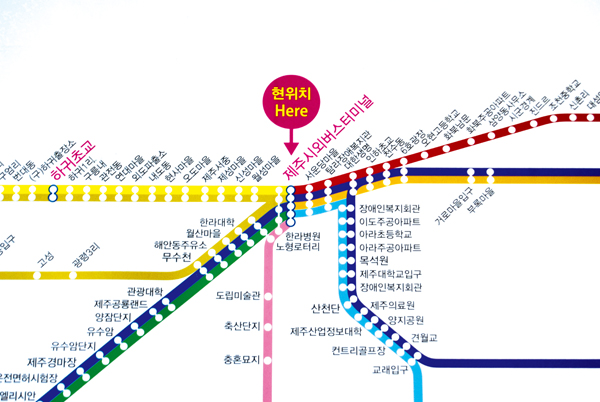
- Updated 2024.5.16 16:06
- All Articles
-
member
icon
-
facebook
cursor
-
twitter
cursor
|
CommunityEditorials and Opinion |
Language, signage and the non-Korean travelerWhile on the island, knowing the Korean writing system is as convenient as it is easy to learn |
|
| |
 |
|
| ▲ A less-than-helpful map in Jeju City's bus terminal. Photo by Todd Thacker |
If you’ve ever traveled around Jeju Island without a car or Korean language skills, you might find yourself stymied by both half measures and good intentions.
Last month I spent a few days with a documentary team from Seoul exploring the ways of getting around the island for visitors who lack knowledge of the region or language. In the former case, I was indeed relatively ignorant, being a new transplant to the island. In the later case, I feigned ignorance of the language to simulate the experience a non-Korean traveler might experience.
The results were interesting. We found a lack of English-language signage at bus stops and bus terminals as well as inconsistent implementation of English in-bus audio announcements. Generally we found that in one part of our journey there would be good explanations in English and then a complete lack of direction in the next.
To give you an idea, here’s a run-down of part of my trip, from a bus stop near my home in Jeju City, to Hallim Port, en route to Biyang Island.
1) The bus from my home to the inter-city bus terminal is 502. At the bus stop there was no English, just hangeul.
2) The bus driver knew enough English to acknowledge that his bus would go to the inter-city terminal. However the in-bus audio announcements were in Korean only, though even a non-Korean speaker can probably listen closely and identify the name of their stop.
3) At the terminal, a huge detailed map of the intercity bus routes takes up most of one wall of the building. It is all in hangeul though, except for the not-so-helpful word “Here.” The ticket sales woman spoke no English, but the Tourist Information Center around the corner had a helpful woman who was able to communicate in English, Chinese and Japanese.
4) After getting an English tourist map of the island from the Information Center, as well as helpful details on the ticket price and bus stop number I needed, I met with another setback. The departure schedule for each bus was listed only in Korean.
5) Yet once on the inter-city bus, all the announcements were conveniently in Korean and English, making the journey to Hallim Port a breeze.
6) Once off the bus, though, all bets were off and I had to ask bystanders for directions (where I had no luck in finding English speakers). After repeated attempts, I ultimately found my way down to the water. (I suppose a GPS device would have helped.)
7) More of the same at the Hallim Port tourism office and later on at Seogwipo’s inter-city bus terminal and museums around the island.
All in all, it’s clear that adequate travel information and signage for non-Korean travelers comes in fits and starts. But while we wait for local and provincial governments to work together, I think learning the Korean writing system is the best way to bridge these gaps in foreigner-friendly signage.
Here’s the thing: hangeul was specifically developed by King Sejong (1397 - 1450) and his scientists to be a writing system that every member of society would be able to learn with ease. Literacy was very low, as the only writing system in Korea at that time was Chinese characters — a time-consuming to learn and unwieldy way to write Korean.
Not only did literacy become something everyone could master, it gave the Korean language and culture independence from a stopgap — and foreign — writing system. I’d like to think that this independence is something we non-Koreans can also benefit from.
So, in the spirit of this great Korean king, I would encourage everyone with a vested interest in Korea and its people to spend a few hours a day on learning hangeul. At the most it will take a few days, and the return on this investment will pay off handsomely.
And by the way, Oct. 9 is Hangeul Day.
For more online resources here is a free site with convenient flashcards: www.quizlet.com/subject/hangul. And for a little more background on the mechanics of the writing system and language: www.langintro.com/kintro/toc.htm
Good luck!
|
|
|
|
|
|
|
 Todd Thacker의 다른기사 보기 Todd Thacker의 다른기사 보기 |
|
ⓒ Jeju Weekly 2009 (http://www.jejuweekly.net)
All materials on this site are protected under the Korean Copyright Law and may not be reproduced, distributed, transmitted, displayed, published without the prior consent of Jeju Weekly. |
|
|
|
|
| Jeju-Asia's No.1 for Cruise |
|
|
|
Title:The jeju Weekly(제주위클리) | Mail to editor@jejuweekly.net | Phone: +82-64-724-7776 Fax: +82-64-724-7796
#503, 36-1, Seogwang-ro, Jeju-si, Jeju-do, Korea, 63148
Registration Number: Jeju, Ah01158(제주,아01158) | Date of Registration: November 10,2022 | Publisher&Editor : Hee Tak Ko | Youth policy: Hee Tak Ko
Copyright ⓒ 2009 All materials on this site are protected under the Korean Copyright Law and may not be reproduced, distributed, transmitted, displayed, published
without the prior consent of jeju weekly.com.

|




















